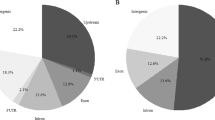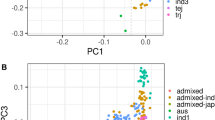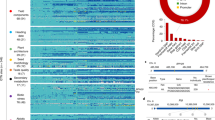Abstract
A high-density haplotype map recently enabled a genome-wide association study (GWAS) in a population of indica subspecies of Chinese rice landraces. Here we extend this methodology to a larger and more diverse sample of 950 worldwide rice varieties, including the Oryza sativa indica and Oryza sativa japonica subspecies, to perform an additional GWAS. We identified a total of 32 new loci associated with flowering time and with ten grain-related traits, indicating that the larger sample increased the power to detect trait-associated variants using GWAS. To characterize various alleles and complex genetic variation, we developed an analytical framework for haplotype-based de novo assembly of the low-coverage sequencing data in rice. We identified candidate genes for 18 associated loci through detailed annotation. This study shows that the integrated approach of sequence-based GWAS and functional genome annotation has the potential to match complex traits to their causal polymorphisms in rice.
This is a preview of subscription content, access via your institution
Access options
Subscribe to this journal
Receive 12 print issues and online access
$209.00 per year
only $17.42 per issue
Buy this article
- Purchase on Springer Link
- Instant access to full article PDF
Prices may be subject to local taxes which are calculated during checkout





Similar content being viewed by others
References
Weigel, D. & Mott, R. The 1001 genomes project for Arabidopsis thaliana. Genome Biol. 10, 107 (2009).
Zhao, K. et al. Genomic diversity and introgression in O. sativa reveal the impact of domestication and breeding on the rice genome. PLoS ONE 5, e10780 (2010).
Huang, X. et al. Genome-wide association studies of 14 agronomic traits in rice landraces. Nat. Genet. 42, 961–967 (2010).
Clark, R.M. Genome-wide association studies coming of age in rice. Nat. Genet. 42, 926–927 (2010).
Clark, R.M. et al. Common sequence polymorphisms shaping genetic diversity in Arabidopsis thaliana. Science 317, 338–342 (2007).
The International HapMap Consortium. A haplotype map of the human genome. Nature 437, 1299–1320 (2005).
1000 Genomes Project Consortium. et al. A map of human genome variation from population-scale sequencing. Nature 467, 1061–1073 (2010).
Fan, C. et al. GS3, a major QTL for grain length and weight and minor QTL for grain width and thickness in rice, encodes a putative transmembrane protein. Theor. Appl. Genet. 112, 1164–1171 (2006).
Mao, H. et al. Linking differential domain functions of the GS3 protein to natural variation of grain size in rice. Proc. Natl. Acad. Sci. USA 107, 19579–19584 (2010).
Saitoh, K., Onishi, K., Mikami, I., Thidar, K. & Sano, Y. Allelic diversification at the C (OsC1) locus of wild and cultivated rice: nucleotide changes associated with phenotypes. Genetics 168, 997–1007 (2004).
Sweeney, M.T., Thomson, M.J., Pfeil, B.E. & McCouch, S. Caught red-handed: Rc encodes a basic helix-loop-helix protein conditioning red pericarp in rice. Plant Cell 18, 283–294 (2006).
Tian, Z. et al. Allelic diversities in rice starch biosynthesis lead to a diverse array of rice eating and cooking qualities. Proc. Natl. Acad. Sci. USA 106, 21760–21765 (2009).
Shomura, A. et al. Deletion in a gene associated with grain size increased yields during rice domestication. Nat. Genet. 40, 1023–1028 (2008).
Weng, J. et al. Isolation and initial characterization of GW5, a major QTL associated with rice grain width and weight. Cell Res. 18, 1199–1209 (2008).
Schneeberger, K. et al. Reference-guided assembly of four diverse Arabidopsis thaliana genomes. Proc. Natl. Acad. Sci. USA 108, 10249–10254 (2011).
Pelak, K. et al. The characterization of twenty sequenced human genomes. PLoS Genet. 6, e1001111 (2010).
Yu, Y. et al. Independent losses of function in a polyphenol oxidase in rice: differentiation in grain discoloration between subspecies and the role of positive selection under domestication. Plant Cell 20, 2946–2959 (2008).
Ren, Z.H. et al. A rice quantitative trait locus for salt tolerance encodes a sodium transporter. Nat. Genet. 37, 1141–1146 (2005).
Mills, R.E. et al. Natural genetic variation caused by small insertions and deletions in the human genome. Genome Res. 21, 830–839 (2011).
Sun, X. et al. Xa26, a gene conferring resistance to Xanthomonas oryzae pv. oryzae in rice, encodes an LRR receptor kinase-like protein. Plant J. 37, 517–527 (2004).
Yano, M. et al. Hd1, a major photoperiod sensitivity quantitative trait locus in rice, is closely related to the Arabidopsis flowering time gene CONSTANS. Plant Cell 12, 2473–2484 (2000).
Dai, L. et al. Genomic structure and evolution of the Pi2/9 locus in wild rice species. Theor. Appl. Genet. 121, 295–309 (2010).
Zhang, Z. et al. Mixed linear model approach adapted for genome-wide association studies. Nat. Genet. 42, 355–360 (2010).
Buckler, E.S. et al. The genetic architecture of maize flowering time. Science 325, 714–718 (2009).
Li, Y., Huang, Y., Bergelson, J., Nordborg, M. & Borevitz, J.O. Association mapping of local climate-sensitive quantitative trait loci in Arabidopsis thaliana. Proc. Natl. Acad. Sci. USA 107, 21199–21204 (2010).
Kojima, S. et al. Hd3a, a rice ortholog of the Arabidopsis FT gene, promotes transition to flowering downstream of Hd1 under short-day conditions. Plant Cell Physiol. 43, 1096–1105 (2002).
Xue, W. et al. Natural variation in Ghd7 is an important regulator of heading date and yield potential in rice. Nat. Genet. 40, 761–767 (2008).
Zhu, B.F. et al. Genetic control of a transition from black to straw-white seed hull in rice domestication. Plant Physiol. 155, 1301–1311 (2011).
Huang, X. et al. Natural variation at the DEP1 locus enhances grain yield in rice. Nat. Genet. 41, 494–497 (2009).
Song, X.J., Huang, W., Shi, M., Zhu, M.Z. & Lin, H.X.A. QTL for rice grain width and weight encodes a previously unknown RING-type E3 ubiquitin ligase. Nat. Genet. 39, 623–630 (2007).
Cui, J. et al. Characterization and fine mapping of the ibf mutant in rice. J. Integr. Plant Biol. 49, 678–685 (2007).
Kump, K.L. et al. Genome-wide association study of quantitative resistance to southern leaf blight in the maize nested association mapping population. Nat. Genet. 43, 163–168 (2011).
Tian, F. et al. Genome-wide association study of leaf architecture in the maize nested association mapping population. Nat. Genet. 43, 159–162 (2011).
The Wellcome Trust Case Control Consortium. Genome-wide association study of 14,000 cases of seven common diseases and 3,000 shared controls. Nature 447, 661–678 (2007).
Myles, S. et al. Association mapping: critical considerations shift from genotyping to experimental design. Plant Cell 21, 2194–2202 (2009).
Lu, T. et al. Function annotation of the rice transcriptome at single-nucleotide resolution by RNA-Seq. Genome Res. 20, 1238–1249 (2010).
Alkan, C., Coe, B.P. & Eichler, E.E. Genome structural variation discovery and genotyping. Nat. Rev. Genet. 12, 363–376 (2011).
Ossowski, S. et al. Sequencing of natural strains of Arabidopsis thaliana with short reads. Genome Res. 18, 2024–2033 (2008).
Kurtz, S. et al. Versatile and open software for comparing large genomes. Genome Biol. 5, R12 (2004).
Rice, P., Longden, I. & Bleasby, A. EMBOSS: the European Molecular Biology Open Software Suite. Trends Genet. 16, 276–277 (2000).
Tan, Y.F. et al. Mapping quantitative trait loci for milling quality, protein content and color characteristics of rice using a recombinant inbred line population derived from an elite rice hybrid. Theor. Appl. Genet. 103, 1037–1045 (2001).
Churchill, G.A. & Doerge, R.W. Empirical threshold values for quantitative trait mapping. Genetics 138, 963–971 (1994).
Irizarry, R.A. et al. Exploration, normalization, and summaries of high density oligonucleotide array probe level data. Biostatistics 4, 249–264 (2003).
Wang, D. et al. Genome-wide temporal-spatial gene expression profiling of drought responsiveness in rice. BMC Genomics 12, 149 (2011).
Jain, M. et al. F-box proteins in rice. Genome-wide analysis, classification, temporal and spatial gene expression during panicle and seed development, and regulation by light and abiotic stress. Plant Physiol. 143, 1467–1483 (2007).
Acknowledgements
We thank the China National Rice Research Institute for providing the rice germplasm samples. We thank S. Griffiths and G. Moore for critical reading of the manuscript. We thank Z. Zhang and E.S. Buckler for helping us use the compressed MLM and Z. Ning for assistance with sequence alignment. This work was supported by the Chinese Academy of Sciences (KSCX2-YW-N-094), the Ministry of Agriculture of China (2011ZX08001-004 and 2011ZX08009-002), the National Natural Science Foundation of China (30821004) and the Ministry of Science and Technology of China (2011CB100205) to B.H.
Author information
Authors and Affiliations
Contributions
B.H. conceived of the project and its components. J.L. and B.H. contributed to the original concept of the project. W.L., Y.G., L.D., D.F., Y.L., Q.W. and Q.F. performed the genome sequencing. X.H., Q.Z., Y.Z., C.Z., K.L., L.S., T.H. and T.L. performed the genome data analyses. Y.Z., C.Z., Q.Z. and X.H. improved the imputation program for the data analyses. X.H., Q.Z. and Y.Z. developed an analytical framework for de novo assembly of the low-coverage sequencing data. X.W., C.L., A.W., T.Z., Y.J., G.D. and Q.Q. collected samples and performed the phenotyping. Y.Z. and X.H. performed the GWAS and statistical analyses. X.H. and B.H. analyzed all of the data together and wrote the paper.
Corresponding author
Ethics declarations
Competing interests
The authors declare no competing financial interests.
Supplementary information
Supplementary Text and Figures
Supplementary Note, Supplementary Tables 4, 6, 7 and 9–12 and Supplementary Figures 1–31. (PDF 14125 kb)
Supplementary Table 1
The list of 950 accessions sampled in the collection. (XLS 181 kb)
Supplementary Table 2
The levels of sequence diversity (π) in each group across the rice genome. (XLS 477 kb)
Supplementary Table 3
The levels of pariwise population differentiation (Fst) across the rice genome. (XLS 382 kb)
Supplementary Table 5
The list of SNP sites with population-special alleles. (XLS 64 kb)
Supplementary Table 8
The detailed list of all the large-effect variations in rice genome. (XLS 788 kb)
Supplementary Table 13
The detailed list of the microarrays used in the study and their related descriptions. (XLS 158 kb)
Supplementary Table 14
The genotype dataset of indica accessions on the causal polymorphic sites of Hd3a. (XLS 32 kb)
Supplementary Table 15
The genotype dataset of indica accessions on the causal polymorphic sites of OsFBX310. (XLS 53 kb)
Supplementary Table 16
The genotype dataset of japonica accessions on the causal polymorphic sites of OsRAL6. (XLS 26 kb)
Rights and permissions
About this article
Cite this article
Huang, X., Zhao, Y., Wei, X. et al. Genome-wide association study of flowering time and grain yield traits in a worldwide collection of rice germplasm. Nat Genet 44, 32–39 (2012). https://doi.org/10.1038/ng.1018
Received:
Accepted:
Published:
Issue Date:
DOI: https://doi.org/10.1038/ng.1018
This article is cited by
-
Genome wide association study identifies donors and candidate genes underlying QTLs for resistance to sheath blight in a collection of Oryza nivara (Sharma et Shastry) accessions
Euphytica (2024)
-
Comparative Proteomic Analysis of High-Temperature Response in Sugarcane (Saccharum spp.)
Sugar Tech (2024)
-
Fine-Scale analysis of both wild and cultivated horned galls provides insight into their quality differentiation
BMC Plant Biology (2023)
-
SNP-based high-density linkage map construction and QTL mapping of black spot disease resistance in Chinese sand pear
Journal of Applied Genetics (2023)
-
Characterization of stilbene synthase genes by comparative genome sequencing of Vitis flexuosa with high contents of stilbene compounds to Vitis vinifera genome
Horticulture, Environment, and Biotechnology (2023)



